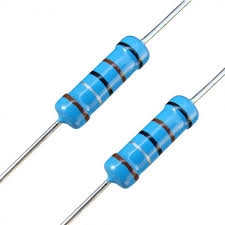Circuit voltage
Calculate the closed-circuit voltage. Calculate the power on the resistors. R1 = 30 ohms, R2 = 10 ohms. I = 0.1A. U =?. The resistors are connected in series, one after the other.
Final Answer:

You need to know the following knowledge to solve this word math problem:
themes, topicsGrade of the word problem
Related math problems and questions:
- Resistances 66064
 Two resistors with resistances of 40 ohms and 60 ohms are connected in series and connected to a voltage of 150V. A) the total resistance B) current in the circuit C) voltage on both resistors
Two resistors with resistances of 40 ohms and 60 ohms are connected in series and connected to a voltage of 150V. A) the total resistance B) current in the circuit C) voltage on both resistors - Resistance 6626
 Two resistors of 20 Ω and 30 Ω are connected in the electrical circuit. a, Calculate the total resistance in the electrical circuit if the resistors are connected in series. b, Calculate the total resistance in the electrical circuit if the resistors are
Two resistors of 20 Ω and 30 Ω are connected in the electrical circuit. a, Calculate the total resistance in the electrical circuit if the resistors are connected in series. b, Calculate the total resistance in the electrical circuit if the resistors are - Lowest voltage
 Three resistors with resistors R1 = 10 kΩ, R2 = 20 kΩ, R3 = 30 kΩ are connected in series and an external voltage U = 30 V is connected to them. On which resistor is the lowest voltage?
Three resistors with resistors R1 = 10 kΩ, R2 = 20 kΩ, R3 = 30 kΩ are connected in series and an external voltage U = 30 V is connected to them. On which resistor is the lowest voltage? - In an electrical 3
 In an electrical circuit, we have R1=4000 Ohms, R2=8000 Ohms, and R3=6000 Ohms connected in series. The power supply has a voltage of 100 V. Calculate the voltage values across R1, R2, and R3.
In an electrical circuit, we have R1=4000 Ohms, R2=8000 Ohms, and R3=6000 Ohms connected in series. The power supply has a voltage of 100 V. Calculate the voltage values across R1, R2, and R3. - Individual 46993
 We measured the voltage U= 75 V between the circuit's external terminals with a voltmeter. The circuit's resistance values of the individual resistors (in series) are 50 Ohm and 100 Ohm. Find out what voltage we would measure on the 1st and 2nd resistor
We measured the voltage U= 75 V between the circuit's external terminals with a voltmeter. The circuit's resistance values of the individual resistors (in series) are 50 Ohm and 100 Ohm. Find out what voltage we would measure on the 1st and 2nd resistor - Resistances 80604
 Resistors with resistances of 6 ohms and 10 ohms are connected in series to a voltage of 24 V. a) How much current passes through them? b) What are the voltages on the individual resistors?
Resistors with resistances of 6 ohms and 10 ohms are connected in series to a voltage of 24 V. a) How much current passes through them? b) What are the voltages on the individual resistors? - A charge
 A charge of 9 C passes through series-connected resistors with resistances of 40 ohms and 60 ohms in 1 minute. a) What voltage are they connected to? b) Calculate the voltage across each resistor.
A charge of 9 C passes through series-connected resistors with resistances of 40 ohms and 60 ohms in 1 minute. a) What voltage are they connected to? b) Calculate the voltage across each resistor.
